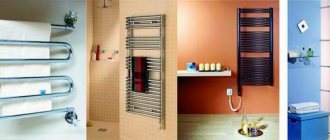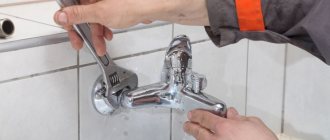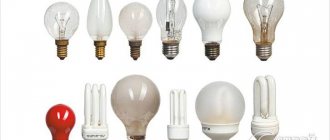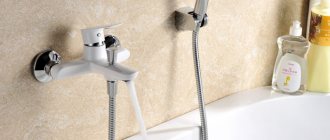The faucet is an important component of the bathroom plumbing system. If this device does not operate correctly, not only does the convenience of hygiene procedures deteriorate, but it also increases the likelihood of a leak that can lead to flooding. Therefore, in the event of a malfunction of this element, which is not associated with clogging of the system or failure of the cartridges, it is necessary to replace the mixer with a new one as quickly as possible.
IMPORTANT! It is recommended to purchase a device that is not the cheapest, since low-budget products, mainly produced by small Chinese enterprises, are short-lived even if all installation rules and operating regulations are observed.
If you have minimal technical skills, time and desire, you should not immediately start looking for a professional plumber, since it is quite possible to change the faucet in the bathroom on your own. With the right approach, this procedure will not take much time and will lead to excellent results.
In what cases is replacement required?
Poor operation of a faucet is not always a reason to replace it.
If water drips or flows in a thin stream from the tap, you just need to replace the filling in it:
- in semi-rotary or lever: ceramic cartridge;
- in classic (valve): gasket.
Some joystick faucets have a metal ball with holes instead of a cartridge. In such devices, the cause of leakage is usually wear of the seat—the soft polymer insert adjacent to the ball—by abrasive particles.
If the tap of a classic valve mixer breaks, replace the tap axle (valve head).
Replacement of the entire device is inevitable in the following cases:
- body cracked. This happens with cheap faucets;
- The inside of the body is covered with rust. Happens with cheap faucets or fakes made from corrosion-unresistant material;
- the nut for connecting to the water supply has burst or its thread has been torn off. This is possible due to careless installation or leaning on the mixer.
Which mixer should I buy?
A new device to replace the old one is chosen based on the design of the locking mechanism, material and design.
Locking mechanism type
Classic valve mixers are considered obsolete - they are inconvenient to use, most users change them to:
semi-rotary
. They are also equipped with two thumbwheels, but to open completely, you only need to turn the tap 180 degrees. To do this, the tap of the valve analogue has to be turned several times. The locking mechanism of the semi-rotary mixer is a cartridge of two ceramic plates with holes. The pressure depends on how well the holes line up. Semi-rotary faucets are more convenient than classic ones, but have the same main disadvantages: each time you have to adjust the water temperature, which increases its consumption, and manipulation requires two hands;- lever _ These faucets are most often installed in the bathroom. There is also a ceramic cartridge inside with holes that more or less coincide with the holes in the seat (water flows through them). The mixing of hot and cold flows occurs in a narrow gap inside the cartridge. There is only one control - a horizontal lever (sometimes a vertical joystick). Turning the lever left and right adjusts the temperature, and moving it up and down adjusts the pressure. It is enough to adjust the temperature once, after which the mixer only opens and closes: saving water. You can open the water by lightly tapping the lever with the back of your wrist: convenient if your hands are dirty.
Faucets with ceramic cartridges (lever and half-turn) are sensitive to water quality: solid mechanical impurities destroy the ceramics, leading to leaks. Therefore, their installation is justified only if there are mechanical cleaning filters on the water lines (called a mud filter or an oblique filter).
Due to very dirty water (it clogs quickly), it is advisable to install a classic valve mixer with gaskets - it is not afraid of mechanical pollutants.
Material
High-quality faucets are made from durable and non-corrosive materials - brass or stainless steel. You can distinguish them by their weight - the devices are quite heavy.
Brass lever mixer
Cheap faucets are made from silumin, an alloy of aluminum and silicon. The material is susceptible to intergranular corrosion, so the device may one day burst, which will lead to flooding. Because of this, it is not recommended to install silumin mixers. You can distinguish them by their weight - they are very light.
Execution
There are three varieties:
- wall- mounted Most in demand. Installed between the washbasin and the bathtub and serves both appliances;
- for mounting on the side of a bathtub or washbasin . They are used if, for example, instead of a bathtub there is a shower stall with its own mixer;
- floor . The mixer is mounted on a stand attached to the floor. They are rarely used and mainly as a designer accessory. They are more expensive than the first two varieties.
Tools and materials
To replace the mixer you will need:
- adjustable wrench (sometimes two);
- pliers;
- screwdriver.
The materials needed are:
- masking tape or electrical tape. They wrap the chrome nuts of the mixer so as not to scratch the coating with the key;
- sealing material for threaded connections.
The following materials are used as compacted material:
- tow or plumbing flax together with Unipak paste;
- fluoroplastic sealing material (FUM tape);
- linen thread "Tangit Unilok".
Experienced plumbers use tow or sanitary ware. It is difficult for a beginner to work with them: if there is an excess amount of sealant, the screw-on part (brass or thin-walled) may burst, but if the tow is not applied, the connection will leak and will have to be repacked. The danger is that the outer part (nut) may burst after some time when the seal absorbs water.
FUM tape
FUM tape is more convenient: if there is excess, the excess material will simply be squeezed out, so you can obviously wind a lot of it, but it has disadvantages:
- leaks after repeated expansion and contraction of the pipeline due to temperature changes. Therefore, it is advisable to use FUM tape only on cold water supplies;
- demanding on the quality of the thread: if there is rust or defects, it forms burrs on the threads and the connection leaks.
Flax thread "Tangit Unilok" is easy to work with and at the same time does not have the disadvantages of FUM tape. To select the correct quantity, no experience is required - the thread is simply wound onto the thread in accordance with the instructions given on the package. With a slight overdose, it does not cause damage to the part. The disadvantage is the high cost.
Who to entrust the work to?
Since you will still have to pay, it is better to do everything at once. In any case, with all the radiators on one riser. And here the question arises: who will carry out this work. To get started, you can go to the housing office or departmental office and ask about their prices. As a rule, the prices there are rather high, and the quality of work is not up to par. To make sure of this, you can ask neighbors who have already dealt with them.
You can find a private owner. Just not from advertisements, but from the recommendations of acquaintances, colleagues, friends. Their prices are rarely higher than those of operators. And the quality is better - this is their bread: if they do a bad job, there will be no customers. That’s why they try (if they are sane) to do everything conscientiously.
Choosing a performer is not an easy task
There is still an opportunity to negotiate with the housing office employee by bypassing the cash register. But here the option is controversial. Firstly, they tend to ask for a price based on the client’s wealth and it is far from a fact that they will demand less than the price list. More likely - more. Why, tell me, should they pay more for the same quality of work (it is unlikely that they will work more diligently than at their main job)?
Another option is to contact a specialized organization. And again, preferably based on recommendations. Although, organizations are forced to monitor the quality of work for prosaic reasons: they need clients. If they have a bad reputation, no one will go to them
Therefore, if you don’t know the organization, there are no recommendations, you can pay attention to the period of its existence on the market. If it’s not a year or two, then they definitely know how to do something, otherwise they wouldn’t have existed for so long
Naturally, pay attention to the services they provide. Many people suggest that issues with permission and disconnection of risers should be handled by the management or operating organization. You just specify the list of works and time. How expensive will it cost? In different ways: organizations, like their leaders, are different. It may be more expensive than the work of a mechanic from the housing office, but at least you will have someone to file a claim with in case of problems: you sign an agreement that will clearly outline who is doing what.
And the most economical option: do everything yourself, with your own hands. It’s not an easy task, but it’s not the gods who burn the pots. Just first you need to find out everything down to the smallest detail, purchase everything you need, prepare tools and equipment, and only after that write an application to turn off the riser.
This all concerned planned repairs or preventive maintenance. If a radiator or pipe is leaking, you definitely have to take action yourself. Read how to fix a radiator leak here.
Dismantling the old tap
The mixer to be replaced is removed as follows:
- shut off the root valves at the entrance of the water supply to the apartment and open the taps on the mixer to relieve excess pressure;
- cover the bathtub and sink with rags so that accidentally falling parts do not damage the enamel or ceramics. It is important to close the drain holes so that small parts do not fall there;
- Use a wrench to unscrew the mixer nuts from the eccentrics. If it gets stuck due to lime deposits, add brake fluid or kerosene and after 15 minutes. try again. In particularly advanced situations, use WD-40 liquid. This composition effectively softens rust, paint, glue and all kinds of deposits, for which it is popularly nicknamed “liquid key”.
After unscrewing the nuts, the old mixer is placed in a basin so that the small amount of water remaining in it does not leak onto the floor.
How to shut off the battery
To perform some work, you only need to turn off the radiator:
If shut-off valves are installed - ball valves. This is easy to do: you need to turn the tap handle until it stops on the supply and return pipes. The coolant flow is blocked, the heater can be removed.
If there are ball valves in front of the radiator, close them and remove the radiator
Sometimes a manual control valve is installed at the supply. It can also shut off the coolant supply, but its main function is to regulate: it is installed to maintain a constant temperature in the room.
If the heating season is over, after closing the taps, you can safely remove the radiator. If there is a need to carry out work during the heating season, it is necessary to take into account the peculiarities of the installation. In a single-pipe system with vertical distribution, shutdown without stopping the system is possible only if there is a bypass.
A one-pipe system with vertical wiring looks like this: one pipe comes out of the ceiling, goes to the radiator, the second comes out of another hole in the battery and goes to the floor.
The bypass is a jumper placed in front of the radiator. It connects the supply and return pipes. It is usually carried out with a pipe size one step smaller than the diameter of the liner.
If there is a bypass, then when the radiator is turned off, the coolant continues to circulate through the riser, but already flows through this jumper. As a result, no one suffers: the neighbors are warm, you carry out the required work.
The bypass is a jumper in front of the battery. In the photo on the right, even though there is a bypass, there is nothing to shut off the battery: there are no ball valves
When connecting using a two-pipe scheme, there are no problems: there are taps, close them, remove the radiator. With a single-pipe system, but with horizontal wiring, jumpers are also needed. But, in their absence, you will freeze your apartment.
In general, a bypass is a very necessary element: if necessary, it allows you to install a thermostat (thermostat) at the inlet of the radiator, with which you can maintain a constant temperature in the room. Without this jumper, installation of control devices is prohibited. It’s just that without it, it turns out that you regulate not only the temperature of your battery, but also the entire riser, which is unlikely to please your neighbors.
But just the presence of a bypass does not guarantee the ability to turn off the battery during the heating season. There should also be ball valves on the supply and return. Moreover, it is better to take full-bore valves for heating radiators. There are also standard ones. In them, the clearance in the open position is approximately 70-80% of the diameter. In full bore models it is 100%. To ensure normal heat transfer, they are exactly what is needed.
The battery can be disconnected at any time if there are ball valves at its inlet and outlet. But to ensure that heat transfer does not decrease, it is necessary to install full-bore models
If there is no bypass, to carry out all this work you will have to turn off the riser, and this is not done soon, and even at a cost.
Installation of a new mixer (wall and floor models)
When installing a new device, proceed as follows:
- inspect the eccentrics. These are bushings screwed onto pipes, one part of which is slightly offset relative to the other. They allow you to set the center distance to the size of the mixer (usually 15 cm), because it is quite difficult to give such an exact position to the pipes. Eccentrics in good condition are left in place; those in poor condition are replaced. If the mixer has been standing for a long time, it is useful to replace the seal in the pipe-eccentric connections. It could become dilapidated, and then particles of the material will pollute the water;
- if necessary, rotate the eccentrics, moving them to the desired position. Everything is done correctly if the distance between the centers of the eccentric holes exactly corresponds to the center-to-center distance for the mixer connecting pipes, and each eccentric is like a mirror image of the second: under this condition, the mixer is located horizontally;
- if necessary, clean the eccentric threads with a wire brush;
- put decorative washers on the eccentrics (wall-mounted mixer);
- wrap a sealant around the threads of the eccentrics. Taking into account the fact that when screwing on the nut it will be distributed further along the thread, slightly more material is placed on the first turns (winding begins from the end);
- wrap the nuts of the new faucet with electrical tape or masking tape so as not to scratch the shiny surface with the wrench;
- manually screw the nuts onto the eccentrics as long as possible;
- having reached the stop, tighten the nuts with an adjustable wrench, turning them a quarter turn;
- remove the masking tape from the nuts and check the operation of the mixer by opening the root valves.
If there are leaks in the connections, they are tightened or repacked after turning off the water.
How to change a bathroom faucet with a shower stand
If your faucet is equipped with a shower stand or panel, or you want to install a hydromassage or simple shower panel, then the replacement will have to be done differently. First, disconnect the stand from the mixer. Loosen with an adjustable wrench and unscrew the rack connecting nuts. If the stand is connected using a flexible hose, simply disconnect the hose. Unscrew the rack fasteners and remove it. Then we dismantle the mixer as described above. If the stand has a flexible connection and you do not plan to change it, then you do not need to remove it.
Shower stand
This is interesting: Sealant for shower cabin: which one is better to choose and what to look for when buying
Installation on a bathtub or sink
The devices are connected to the water supply via a flexible connection and operate as follows:
- a hole with a diameter corresponding to the size of the mixer is drilled in the side of the bathtub or washbasin. To form such holes, crowns (cylindrical drill) are used, and if such a tool is not at hand, many holes are drilled along the contour with an ordinary drill and then the spaces between them are broken with pliers;
- Place the gasket on the side and install the mixer, threading the connecting pipes into the hole. The device is secured from below with a horseshoe washer and nut (a gasket must be put on first);
- connect the mixer pipes and pipes with a flexible liner. There is no need to seal the connections - the liner nuts already have gaskets. To avoid crushing them, excessive tightening is contraindicated.
If the flexible liner leaks, it is not necessary to completely change it: videos have been published on the Internet with instructions for installing a cracked polymer tube inside the braid. Repair is significantly cheaper than buying a new product.











